#lizard-like fossil
Explore tagged Tumblr posts
Photo

RARE Keichousaurus hui Fossil, Triassic Reptile, Guanling Formation, China | Genuine Specimen + COA
RARE Keichousaurus hui Fossil from the Guanling Formation, Triassic Period – Guizhou Province, China
This extraordinary fossil features the complete or near-complete remains of Keichousaurus hui, a marine reptile that lived approximately 240 million years ago during the Middle Triassic epoch. Unearthed from the world-famous Guanling Formation in Guizhou Province, China, this specimen is a rare and scientifically significant piece, perfect for fossil collectors, natural history enthusiasts, and educational displays.
Fossil Type & Species:
Type: Vertebrate Fossil (Reptile)
Species: Keichousaurus hui
Order: Sauropterygia
Superfamily: Pachypleurosauroidea
Family: Keichousauridae
Identified by: Originally described by Chinese palaeontologist Yang Zhongjian (Chung-Chien Young) in 1958
Geological Details:
Formation: Guanling Formation
Period: Triassic (Anisian Stage, Middle Triassic – approx. 247 to 237 million years ago)
Zone/Biozone: Not formally assigned to a specific biozone but typical of the fossil-rich marine strata of the Anisian
Depositional Environment: Shallow marine lagoon or shelf setting with fine-grained sedimentation, ideal for exceptional fossil preservation
Morphology & Features:
Keichousaurus hui is a small marine reptile resembling a lizard in body shape. It is characterized by:
A long, slender neck with approximately 25 cervical vertebrae
Four well-developed flipper-like limbs adapted for swimming
A long tail used for propulsion
Clearly defined ribs and vertebral column
In some specimens, you can observe fine details such as skull structure and even gastralia (belly ribs)
This particular specimen exhibits excellent articulation and preservation, with visible limb bones, vertebrae, and overall body outline.
Specimen Details:
Origin: Guanling Formation, Guizhou Province, China
Species: Keichousaurus hui
Age: Middle Triassic (Anisian Stage)
Matrix: Fine-grained limestone slab
Fossil Type: Full or near-complete articulated skeleton
Size Reference: Scale rule square = 1cm (please see photo for full sizing)
Note: You will receive the exact fossil specimen shown in the photographs
Authenticity & Quality:
We carefully select all our fossils based on scientific relevance, aesthetic quality, and authenticity. This specimen is 100% genuine and comes with a Certificate of Authenticity. The photo shows the actual fossil you will receive, not a stock image.
Why Choose This Fossil?
This Keichousaurus hui fossil is a standout example of Triassic marine reptile life, making it an ideal piece for:
Palaeontological study
Educational collections
Museum-quality display
Gifts for fossil enthusiasts or students
Shipping & Packaging:
We use eco-conscious, secure packaging to ensure your fossil arrives safely and in excellent condition. Fast and careful dispatch provided.
Add a genuine piece of prehistoric marine life to your collection with this stunning Keichousaurus hui fossil.
All of our Fossils are 100% Genuine Specimens & come with a Certificate of Authenticity.
#Keichousaurus hui fossil#Triassic reptile fossil#Guanling Formation#Guizhou Province fossil#Chinese dinosaur fossil#rare reptile fossil#authentic Keichousaurus#Triassic marine reptile#lizard-like fossil#genuine fossil specimen#fossil with COA#prehistoric reptile fossil#collector fossil#palaeontology specimen#fossil reptile plate
0 notes
Text
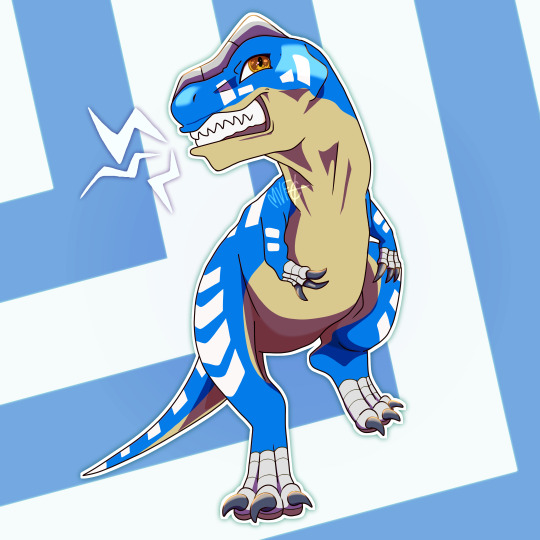
It's Big Al!!!!!!!!
#mvf art#fossil fighters#allo#vivosaur#vivosaurs#fossil fighters allo#big allo#fossil fighters big allo#fossil fighters vivosaur#i love how the Big Allo in Frontier is named after Big Al <3#i have a VHS copy of the Walking with Dinosaurs special on Big Al#and I used to rewatch it all the time- it's one of the reasons i love large theropods#(and i used to eat spaghetti like how Al eat that lizard but ahaha that's a story for another time)
24 notes
·
View notes
Text
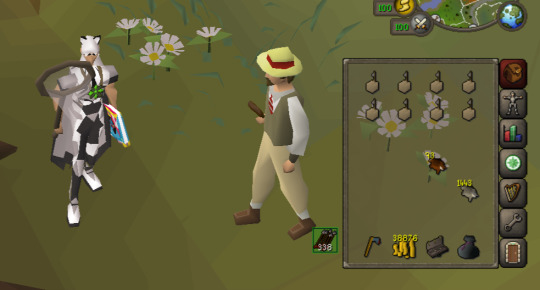

In case you were wondering
Ultimate iron btw 😏
#prolly just gonna release the chins XD#we just like them so much more than lizards okay#and we need either like 500k we don't have to buy a cannon or 83 Hunter for dragon bones so we can do watchtower at least to skavid caves#so we can poison dynamite#or just buy a cannon and try spawn hitting#point is#we need bat bones to get to fossil Island#and they are in the bat
14 notes
·
View notes
Text
World-Building Guide to Deserts

A desert is a vast biome that is known for its extreme temperature. Deserts can either run hot or cold and are usually difficult to inhabit. But deserts are harsh places but they are visually stunning and make for an impressive backdrop to any story.
What is it like in the Desert?
Like I said, deserts are hot or cold. The temperatures are extreme which limits the amount of vegetation which in turn limits the coverage one can get in a desert, leaving the area very exposed to the elements. Rainfall is limited, well below average which means only very durable vegetation and wildlife can survive. It is a harsh landscape but it has its own beauty. The desert can often be very quiet with the limited wildlife and people around.
Hot Deserts

Features of Hot Deserts
Sand Dunes: These are hills made of sand, shaped by the extreme winds.
Plateaus: These are flat areas, usually of rock that have very little vegetation or cover.
Salt Flats: Large areas of salt deposits
Playa Lakes: Temporary lakes that appear during heavy rainfall
Oases: Small areas within the desert that have fertile soil and flourish with vegetation due to a water source.
Canyons: Are deep valleys of rock formed from rivers long dried up or greatly reduced.
Sedimentary Layering: Striped rock that shows off the different layers of rock giving the desert a striped appearance.
Mesas: A mesa is flat elevation of steep sides.
Inselbergs: Isolated rock formations that jut up from the desert floor, formed out of soft rock.
Yardangs: Ridges of rock formed by wind erosion
Mushroom Rocks: Pillars of rock formed over time with bigger heads than their bases
Rocks Commonly Found in Hot Deserts
Quartz: Clear/white/pink and usually smoky or clouded. Quartz feels very smooth like glass and may look like crystal.
Sandstone: Tan/red/yellow/brown-ish in colour. Made of compacted sand, it feels very coarse.
Limestone: Grey/white. Rough to touch and often featuring fossils.
Gypsum: White/Clear/Pink/Grey. Soft with chalk-like texture.
Salt Crystals: White/Clear. Crystal-like.
Meteorites: Often found in deserts. Usually black/grey. Can be both rough or smooth to touch.
Common Plants in Deserts
Prickly Pear Cactus: Greed, waxy pad-like cacti with spins. They grow red/yellow fruit that are edible.
Mesquite Trees: Small twisting trees. The pods are edible.
Agave: A thick-leafed succulent, shaped like a rose full of nectar and water.
Oleander: A shrub with pink or white flowers. Not edible, poisonous.
Chia Seeds: Tiny seeds that are edible.
Date Palms: Tall with long sweeping fronds. The dates are edible.
Jojoba: A shrub that's seeds are edible.
Desert Mallow: Flowering plant of pink blossoms. The leaves and flowers are edible.
Peyote: Small round cactus. Do not eat.
Creosote Bush: A shrub with waxy leaves that can be eaten.
Common Wildlife in a Hot Desert
Snakes
Small rodents
Foxes
Raptors (the birds of prey not the fun kind)
Beetles
Scorpions
Locusts
Coyotes
Camels
Lizards
Tortoises
Surviving a Hot Desert
Shelter: It is imperative to stay out of the direct sun if possible to conserve energy.
Keep an eye out: In the shade, there are other creatures who want to get out of the sun. Venomous snakes, scorpions and other critters could be lying in wait so it is best to make sure your shelter isn't already occupied.
Travel: Moving when it is sunrise or sunset or night is best as it isn't as hot and you waste less energy.
Water: Limit water intake in case your character doesn't reach a water source soon. If there are cactus around, your character may find water within it.
Know your plants: Your character might feel the urge to eat any vegetation they come across if they are hungry and weary. There are edible plants in the desert but there are also poison ones. Your character shouldn't eat any strange plant without knowing what it is.
Getting help: Signalling using something reflective or creating a large symbol might signal for help from above.
Clothes: A character should remember that the desert is hot and dress accordingly. Light, loose clothing is best but the nights in a desert are extremely cold. If your character is modifying their clothes, make sure they remember this.
Cold Deserts

Features of Cold Deserts
Ice Sheets: Unbroken sheets of permanent ice.
Glaciers: Immense sheets of moving ice.
Permafrost: The ground that remains frozen all year round. It is barren and nothing can grow here.
Icebergs: Vast lumps of ice that break off from larger sheets of ice to float in the ocean (and kill Leonardo DiCaprio)
Rocky Outcrops: Exposed rock formations.
Crevasses: Deep cracks in ice sheets and glaciers, very dangerous.
Seracs: Ice formations created where multiple crevasses meet.
Erratics: Large rocks deposited by glaciers seemingly in the middle of nowhere.
Rocks Commonly found in Ice Deserts
Basalt: Grey/Black. Smooth.
Granite: Grey/Pink/White. Coarse to the touch.
Shale: Grey/Black. Smooth and brittle.
Gneiss: Striped with greys/pinks/white. Rough texture.
Schist: Silvery-green. Flaky and layered.
Till: Of many colours. Rough.
Common Vegetation found in Ice Deserts
Lichens: Crusty spots that grow on ice and rocks. Can be edible.
Mosses: Soft green plants that grow in the damp. Some kinds are ok to eat.
Arctic Willow: A shrub. Edible.
Saxifrages: Flowering plants growing in rocky areas. Some are edible.
Bearberry: A shrub. The berries are edible.
Grasses: Grow in tundra areas. Edible.
Wildlife Commonly Found in the Ice Desert
Bears
Foxes
Wolves
Deer
Elk
Walrus
Moose
Reindeer
Seals
Whales
Ice worms (the spice must flow....)
Rodents
Surviving in an Ice Desert
Clothing: Wearing layers is crucial. Base layer, insulation and a waterproof layer. Boots and gloves are a must. But you should dress to be sweating, it is a waste of energy. Stay dry always.
Shelter: You can find or build shelter, especially if the winds are high. If sleeping on the ground, use insulation.
Food/Water: Melting snow and ice is fine, eating snow is bad because it will lower your core temp. The best food to eat in this weather is high in fat to keep your body working to keep warm.
Keeping an eye out: Ice fields can break apart easily, crevasses are lethal.
Flag for help if lost: Flares or fires can attract help so always carry something to spark up a flame or two.
#worldbuilding#worldbuilding guide#worldbuilding reference#worldbuilding resource#worldbuilding guide to deserts#writing#writeblr#writer#spilled words#writer's problems#writing advice#writer's life#writing resources#writing reference#worldbuilding help#writing help#creative writing#wtw#wtwcommunity
370 notes
·
View notes
Note
Are there any amphibians/reptiles/birds that are considered living fossils? or are like sorta close to being such. Itd be neat to see methinks =^]?
Living Fossils:
So, I am usually leery of using the phrase "living fossil", because it elides the fact that all creatures living today are equally the products of ~3.5-4 billion years of evolution.
However, I get the idea... animals that seem to be from older groups (many of which are no longer around) and seem to have not changed too much over millions of years, get labelled "Living Fossils".
Crocodilians are sometimes referred to in this way, but the reptile that usually gets this is from an ancient group, called the Rhynchocephalia.

Tuatara (Sphenodon punctatus), family Sphenodontidae, order Rhynchocephalia, endemic to New Zealand
There were once 2 recognized species of Tuatara, but now they are considered to be just one species.
This is not a lizard.
This is the only member of the reptile group Rhynchocephalia that is still around. All other species went extinct millions of years ago.
Tuataras were eradicated by humans and introduced species from the main islands of New Zealand, and now only occur on small islands near the North Island and far north of the South Island. (*There has been some modest success re-introducing them to the main islands.)
This is one of my very favorite animals!!!
photograph by Houston Chandler

photograph by Sid Mosdell

photograph by Chung-Wei Logan You

EAT A TASTY WETA!!!
photograph by Ryan Photographic
ANOTHER SPECIES OF REPTILE THAT IS CONSIDERED "PRIMITIVE" IN ITS ANATOMY:

American Pipe Snake aka False Coral Snake (Anilius scytale), family Aniliidae, Peru
This family is monotypic, containing only this species.
This species is considered to be quite primitive, in its anatomy, amongst snakes.
Coral snake mimic.
photograph by Nick Volpe


photographs by Vincent Prémel
307 notes
·
View notes
Text
LEONA VS MALLEUS FOR LUNCH
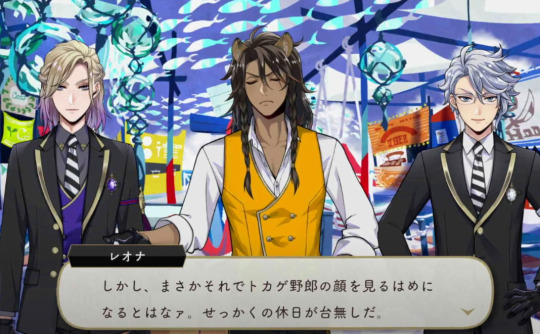
Leona: "I also go out in the sun sometimes. But I never thought I'd end up seeing that goddamned lizard's face. Ruined my precious holiday."


Sebek: "Ha?! Who are you talking about? I am not a lizard." Leona: "Ain't you. I'm talkin' about Horns over there."
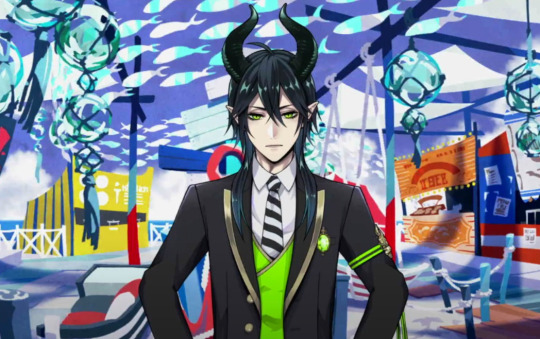

Sebek: "... Wha, wh, what..! WHAT DID YOU SAY?! DAMN YOU, THE UTTER DISRESPECT!!" (Note: Sebek does not curse, but he addresses everyone with a rude pronoun.)
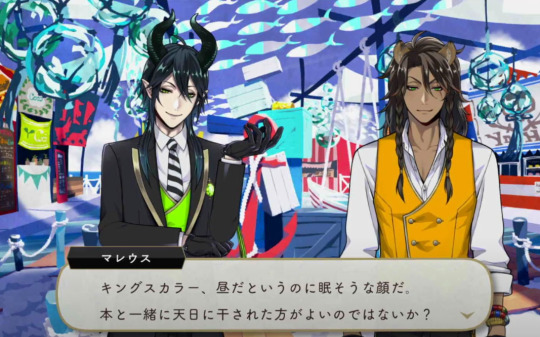
Malleus: "Kingscholar, you still look quite sleepy even in the height of the sun. Won't it benefit you to tan your hide among the leather books?" (Because he's implying Leona should be skinned like an animal 😭)

Leona: "Right back at ya. It'll be far too late once moss starts growing on those horns." (He's saying Malleus is a fucking fossil weathered with time 😭)


Vil: "Don't you start fighting in this crowd. You'll scare off the customers."
#twisted wonderland#ventique translates#malleus draconia#leona kingscholar#vil schoenheit#twst event spoilers
460 notes
·
View notes
Text

Coming right around the Chinese New Year, top to bottom, are two highly scientifically-important dinosaurs hailing from the Aptian-aged (125-118 mya) Jiufotang Formation of China’s Liaoning Province:
Microraptor zhaoianus ranks alongside the late Jurassic Archaeopteryx and the closely-related Sinornithosaurus as one of the first theropod dinosaurs ever to have discovered with full feather and wing impressions. It measured about 80 cm (2.6ft) in length, had a wingspan of 99 cm (3.25 ft) and weighed about 1.25-1.88 kg, sported a uniquely black but iridescent plumage, and is the namesake of the Microraptoridae, a family of raven-sized dromaeosaurs that dominated the Jehol Biota of the Jiufotang and Yixian Formations and are particularly famous for sporting long flight feathers on both their legs and limbs. This “four-winged” configuration, which surprisingly resembles the hypothetical “Tetrapteryx” stage of bird evolution proposed by naturalist William Beebe in 1915, enabled Microraptor and its kin to glide from tree to tree in pursuit of small birds, lizards and mammals as well as achieving some sort of powered flight over short distances.
Psittacosaurus is a basal ceratopsian that is closer in phylogeny to creatures like Styracosaurus and Triceratops than to the more primitive Yinlong from the late Jurassic, and is one of the most well-preserved and best-studied genera of all non-avian dinosaurs. It reached the size of a pig or a retriever dog and lived throughout much of continental Eastern Asia 125-105 million years ago, and is known for having the most species described of any non-avian dinosaur, with 12 different species ranging from as far north as Siberia to as far south as Thailand. Two of these species were both found in the Jiufotang Formation - P.melieyingensis and P.mongoliensis, the type species which measured up to 2 meters (6.2 ft) long and weighed about 80 kg (44 lb). Psittacosaurus had highly-developed senses of smell and vision, a pair of protruding jugal (cheek) bones that were possibly used for display, and was active for short periods at day or night. Psittacosaurus also possessed self-sharpening teeth that were used for cropping and slicing tough plants, and unlike future ceratopsians, it lacked teeth for chewing and grinding food and thus used gastroliths (which would have been stored in a gizzard similar to those of modern birds) to wear down the leaves and bark that it ate as it passed through the digestive system. Psittacosaurus is also unique among ceratopsians for having a large, well-proportioned brain. This indicates that the dinosaur was capable of doing a wide range of complex social behaviors such as bird-like sleeping, nest-building and parental care. This is perhaps true with possible instances of overburdened Psittacosaurus parents brining in a nanny or another guardian to take care of large nests of more than a dozen hatchlings, as evidenced of fossils of adolescent females preserved with several hatchlings together. The Psittacosaurus of the Jiufotang Formation shared their temperate forest habitat with the basal ankylosaur Chuanqilong, several genera and species of paravians and pterosaurs, a large titanosaur, and the 10-meter-long Yutyrannus relative Sinotyrannus, and Psittacosaur hatchlings and occasionally adults were also preyed upon by the large, badger-like mammal Repenomamus. One fossil Psittacosaurus specimen that is on display at a German museum (SMF R 4970) preserves the scales, colors and integument that the living animal would have had, and they indicate that the particular Psittacosaurus had a counter-shaded reddish brown and beige pattern that was blurrier and less-defined compared to the striking orange-and-white colors of Sinosauropteryx (which was suited for a lifestyle of foraging in open areas) and was therefore useful for camouflaging the Psittacosaurus in the woods. The specimen also possessed a strange crest of yellow, keratinized, bristle-like structures protruding from the base of its tail that were quite similar to the thin, filamentous structures found on the heterodontosaurid Tianyulong, which also possibly indicates that feather-like structures or proto-feathers may have appeared early in the evolutionary history of the dinosaurs and were soon lost in the evolution of some dinosaur groups or retained in some form in the evolution of others.
#microraptor#psittacosaurus#paleoart#dinosaur#dinosaurs#paleontology#paleontology art#paleoblr#paleoartists on tumblr#dromaeosaurid#ceratopsians#ceratopsian#dromaeosaur#dinosaur art#dinosaur artwork#cretaceous#early cretaceous#aptian#albian#dinoblr#palaeontology#palaeoart#paleontography
320 notes
·
View notes
Text
some jeremy johnson fun facts
he still has all his baby teeth
his mother's name is strongly implied to be Hawkeye
he carries a drain unclogger around with him
his favorite dessert is jello
he couldn't remember the phrase "leaping lizards" when prompted but can recognize a platypus mom suit on sight
he likes camping
he LOVES larping
he likes rice chex
he regularly does charity work/activism (building houses for the homeless, charity pet wash, chaining himself to a tree, etc)
he is the heaviest sleeper in the entire tri state area
his grandmother was on a roller derby team called the saskatoon slashers, implying that some of his family is from canada. however, he also has british ancestry and an australian cousin. white boy alert
he once left candace 11 messages in a row
he had a crush on candace before she had a crush on him
he abandoned his vacation in paris and possibly his family to go home and kiss his girlfriend
he took her on a date to a car wash once
he has a mini safe in his closet with only a chewed-up pencil in it (candace lent it to him in grade school)
he did not question the fact that there was a fossil in the natural history museum that said C+J inside a heart
he was once a foot model
he likes mani/pedis
he has weird nicknames for almost everyone he knows
his entire family has J shaped birthmarks
he got phineas and ferb to build an exoskeleton to help him dance on a tv show
the part of his job he hates the most is cleaning the bathrooms
he will NEVER DIE
972 notes
·
View notes
Text
Round 3 - Actinopterygii - Osteoglossiformes
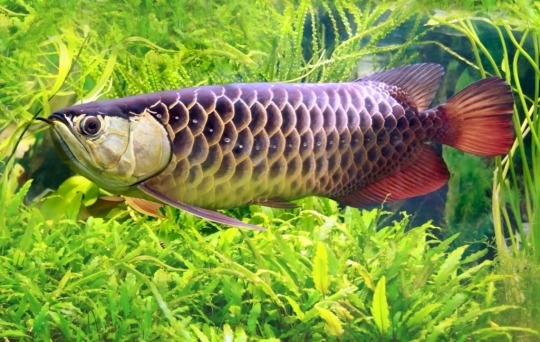
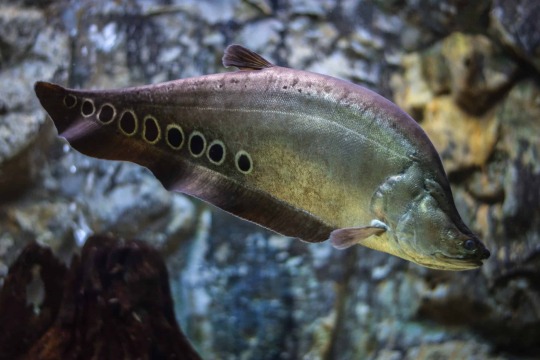


(Sources - 1, 2, 3, 4)
Order: Osteoglossiformes
Common Name: no common name for the whole order
Families: 6 - Pantodontidae (“Freshwater Butterflyfish”), Osteoglossidae (“bonytongues” and “arowanas”), Arapaimidae (“arapaimas”), Notopteridae (“featherback knifefishes”), Gymnarchidae (“African Knifefish”), and Mormyridae (freshwater elephantfish”)
Anatomy: elongated body; toothed or bony tongues; long or absent dorsal and anal fins positioned near the caudal fin; large swim bladder enables them to breathe at the surface of the water; most are adapted for surface feeding
Diet: arthropods, fish, snails, frogs, lizards, snakes, mice, bats, and small birds
Habitat/Range: slightly acidic freshwater in South America, Africa, Australia, and Southern Asia
Evolved in: Late Jurassic
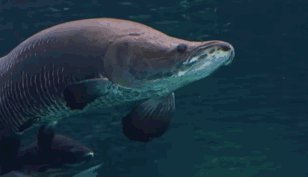
(source)
Propaganda under the cut:
Freshwater Butterflyfish (Pantodon buchholzi) (image 4) have very large pectoral fins. If enough speed is built up underwater, a butterflyfish can jump and glide a small distance above the surface to escape predators. It wiggles its pectoral fins as it glides, with the help of specialized, enlarged pectoral muscles.
Arowanas (genus Osteoglossum) can jump up to 2 m (6.6 ft) out of the water to pick their prey off of branches, tree trunks or foliage, which has earned them the local name "water monkeys". They are the largest fish in the world to catch most of their food out of water.
Male arowanas brood their young within their mouth, only fully releasing them when they are about 7 cm (2.8 in) long.
The endangered Asian Arowana (Scleropages formosus) (image 1) is also known as the “dragonfish”, due to its large metallic scales and long barbels giving it a resemblance to the Chinese dragon. The popularity of this beautiful, auspicious fish has had both positive and negative effects on their status as endangered species, as they are in high demand in the home aquarium trade. Legal pet Asian Arowanas must be bred in captivity on a fish farm for at least two generations, have a certificate of authenticity and a birth certificate, and an implanted microchip to identify the individual. There are over 150 CITES-registered Asian Arowana farms in Singapore, Malaysia, Indonesia, and other Southeast Asia countries, producing Asian Arowana for commercial purposes. But the actual number of Asian Arowana farms in the world could be much higher than that, probably over 350, the majority of them unregistered.
The Arapaima (Arapaima gigas) (see gif above) is the largest truly freshwater fish, commonly measuring 200 cm (6.6 ft) with records of up to 450 cm (15 ft). Adults may weigh up to 200 kg (440 lb).
Arapaima parents have been observed using their mouths to dig holes in the substrate to create a nest for their eggs. The males will remain by the nest to protect their offspring for three to six months.
Arapaima are becoming increasingly rare in their native habitat of the Amazon and Tocantins-Araguaia river basins, but are invasive in Bolivia and Indonesia after purposeful and accidental releases.
A 13-million-year-old fossil of an Arapaima (or very similar species) has been found in Colombia, in the Villavieja Formation, which dates from the Miocene epoch.
The African Arowana (Heterotis niloticus) (actually a relative of arapaimas rather than arowanas) is the only Osteoglossiform to feed extensively on plankton.
Native to freshwater habitats in Cambodia, China, Hong Kong, Laos, Macau, Thailand, and Vietnam, the Clown Featherback (Chitala ornata) (image 2) is considered one of the world’s most invasive species, as it often outgrows home aquariums and is then released into the “wild” outside its native range.
The Giant Featherback (Chitala lopis) was declared to be extinct in 2020, but a small surviving population was rediscovered on Java, Indonesia in 2023.
The African Knifefish (Gymnarchus niloticus) and freshwater elephantfishes (family Mormyridae) (image 3) are able to produce a steady but weak electric field, used for finding their prey, usually small invertebrates buried in muddy substrates.
The African Knifefish can swim equally well forwards or backwards, relying on its electric senses to “see” behind it.
Freshwater elephantfish are known to have a large brain size and unusually high intelligence.
The Medjed (likely a fish in the genus Mormyrus) was a kind of elephantfish sacred in the city Oxyrhynchus, in ancient Egyptian religion, as the fish that ate the penis of Osiris. Archaeologists have found fishes depicted as bronze figurines, mural paintings, or wooden coffins in the shape of fishes with downturned snouts, with horned sun-disc crowns like those of the goddess Hathor.
#FAV FOR ME Arowanas and Arapaimas by beloveds#also fell in love with the butterflyfish and elephantfish at the Georgia Aquarium#animal polls#Osteoglossiformes#Actinopterygii#Round 3
134 notes
·
View notes
Text
V Perpetua - my headcanons
I think so far I’ve seen enough of him to develop some personal headcanons for Perpetua.

Perpetua is human to me, but a very strange kind of human. However, he wears a mask because he doesn’t want to be perceived as one.
He’s mostly nocturnal, has a history of selective mutism, and is terribly afraid of social gatherings. When he has to participate, he has absolutely no idea how to interact with so many people. In trying to seem “normal,” he ends up acting like one of those aliens from Men in Black, the ones wearing human skin but moving in incredibly awkward ways. He’ll say something weird, completely out of context, and people won’t know how to react. He’ll think he did a great job.
He’s absolutely clueless. Always. Completely uninterested in the world around him, he lives mostly in his own mind and frequently dissociates. Too bad, his mind isn’t a nice place. You’ll try explaining what he has to do on stage, and he’ll just stare up at the giant structure, imagining how it would look with real human heads hanging from the ceiling.
As a result, you can’t have a real conversation with him. He’s too unpredictable, and his attention span is too fleeting. Having a meeting with him is one of the most frustrating experiences.
When he was a child, he used to stare at people, a lot. From windows, from inside a car, from a distance, or even directly in front of them. He would stare them down for endless minutes with wide, unblinking eyes, making everyone deeply uncomfortable.
He can’t sit properly. You’ll most likely find him crumpled up in a chair, looking at you like an owl.
He’s only relatively interested in sex, in the sense that he rarely thinks about it or seeks it out. His mind is too detached and chaotic, and carnal lust isn’t his first choice when it comes to seeking pleasure. But when he does engage... he’s freaky. He has some peculiar kinks. Strange shit go on in his bedroom (and not only). He usually doesn’t need to have full-on sex to be satisfied: he just needs to practice his kinks. Most of his occasional partners don’t want to “have sex” with him again.
He listens to a wide range of music, from black metal to techno rave. He can go from Mayhem to Die Antwoord in an instant.
He has a passion for taxidermy that began when, as a child, he used to find dead lizards and snakes and cut them open to see what was inside. He’s not very good at it, though… his creations are terrible.
He collects real animal skeletons and fossils.
The only request he made as Papa was for a private laboratory. What he does in there is a secret, but techno music can always be heard when he’s inside.
He smiles a lot, mostly out of uncontrolled excitement, but since he can’t quite act like a regular person, his smiles are unnaturally wide and unsettling.
Although not many people knew of his existence, he spent a lot of time studying the old Papas. As a result, he often quotes their speeches during his concerts—but he’s no copycat. Sometimes he evokes their words and leaves them incomplete, adds something personal, or even mocks them. It’s as if he’s saying, “Do you remember this? Well, I’m not the same.”
Unlike the other Papas, he’s not in competition with anyone, nor does he want to conquer anything. He was simply pushed onto a stage, and now he just does the thing. His real interests lie outside his musical career.
Sister Imperator is still trying to figure out whether he’s the greatest mistake she’s ever made.
#the band ghost#papa v perpetua#skeletá#the band ghost headcanons#the band ghost lore#Papa v perpetua headcanons
86 notes
·
View notes
Text
Archovember 2024 Day 26 - Compsognathus longipes
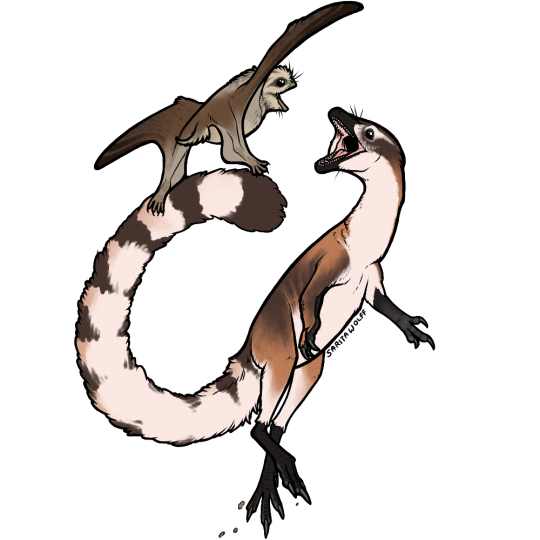
Before it was confirmed that birds were dinosaurs, Compsognathus longipes was regarded as the smallest dinosaur for decades. About the size of a chicken, its name means “elegant/refined/dainty jaw”. It lived in Late Jurassic Europe, found thus far in both Germany and France, with possible teeth also found in Portugal. It was carnivorous, and the remains of small lizards were found preserved in both fossil specimens. They were likely fast, scurrying animals, using their long tails for balance.

In the Late Jurassic, Europe was a dry, tropical archipelago at the edge of the prehistoric Tethys Sea. Both Compsognathus specimens were preserved within lagoons, possibly having died chasing lizards on the beach and then being swept out to sea in a flash flood. The German specimen is known from the Painten Formation, a part of the Solnhofen Limestone. The French specimen was found in limestone on the plateau of Canjuers. One of Compsognathus’ most famous contemporaries is the avialan Archaeopteryx, and the two may have competed over prey. It would have also lived alongside early pterosaurs like Propterodactylus, Rhamphorhynchus, and Anurognathus (as seen above). There were also a diverse variety of turtles, rhynchocephalians, and lizards living here as well, many of which served as prey for this tiny, catlike predator.

This art may be used for educational purposes, with credit, but please contact me first for permission before using my art. I would like to know where and how it is being used. If you don’t have something to add that was not already addressed in this caption, please do not repost this art. Thank you!
#Compsognathus longipes#Compsognathus#compsognathid#theropods#saurischians#dinosaurs#archosaurs#archosauromorphs#reptiles#Archovember#Archovember2024#Dinovember#Dinovember2024#SaritaDrawsPalaeo#Late Jurassic#Germany#France#Portugal#Painten Formation#Solnhofen Limestone#Solnhofen Limestone Formation
149 notes
·
View notes
Text
"I don't know what words to use anymore!"
That's okay! I will help!
Do you mean "the evolutionary group that consists of all things called dinosaurs"? ----- use the word Dinosaur!
Do you mean "what we classically considered dinosaurs"? ----- use the term Nonavian Dinosaur!
Do you mean "dinosaurs that are studied by paleontologists"? ----- use the term Fossil Dinosaur!
Do you mean "any organism studied by paleontologists"? ----- use the term Fossil Organism!
Do you mean "dinosaurs from before history"? ----- use the term Prehistoric Dinosaur!
Do you mean "any living thing from before history"? ----- use the term Prehistoric Life!
Do you mean "just the dinosaurs that survived the end-Cretaceous mass extinction"? ----- use the term Neornithine! or bird. or Cenozoic Dinosaur.
Do you mean "just the dinosaurs that are around today"? ----- use the term (Living) Bird! or living dinosaur
Do you mean "Dinosaurs and Pterosaurs/Pterodactyls"? ----- use the term Ornithodiran!
Do you mean "Just the dinosaurs from the Mesozoic Era"? ----- use the term Mesozoic Dinosaur!
Do you mean "large classical reptiles"? ----- use the term Large Nonavian Reptiles
Do you mean "big lizards"? ----- then you aren't talking about dinosaurs, even a little bit, and should just say Big Lizards
Do you mean "something that is an evolutionary dead-end"? ----- there's no such thing; most organisms go extinct bc of happenstance, not because they were doomed to fail. lol.
Do you mean "something old and outdated, behind the times"? ----- then say Something old, outdated, or behind the times
Do you mean "something that hasn't evolved or changed in millions of years"? ----- No such thing. Every population is constantly evolving, and if something looks unchanged, that just means the change happened somewhere you can't see it.
Do you mean "something that looks like it hasn't evolved or changed in millions of years"? ----- I still recommend you drop this idea from your brain, but if you MUST, use "living fossil" or "prehistoric vibes". living fossils aren't a thing btw.
Do you mean "Dimetrodon"? ----- then say Dimetrodon
Do you mean "any large reptile that is extinct"? ----- then say Extinct Reptilian Megafauna (and accept that includes some large birds)
Do you mean "any large [traditional] reptile that is extinct"? ----- then say Extinct Nonavian Reptilian Megafauna
Do you mean a big reptilian monster? ----- then say Monster
I'm sure there are some I'm forgetting but here you go! words and terms that mean things!
#dinosaurs#birds#birds are dinosaurs#what is a dinosaur#paleontology#prehistoric life#this is *not* the FAQ post
2K notes
·
View notes
Text
Some recent croc encounter
Ive been on „vacation“ last week which honestly was mostly taking a friend to various zoos and aquariums across Austria, but that did lead me to getting to see a fair share of crocs in a fairly short time span.
Right on day 2 it was another meeting with Leila, the female Mecistops that resides in Viennas aquarium. This is now my second time seeing her and shes still a beauty.


A day later we visited the House of Nature museum in Salzburg, which had just opened its new reptile halls. As part of the makeover, which focused a lot on cohabitation and larger, natural exhibits, the museum had go part with its American Alligator that had simply become too large. While I did subsequently miss out on seeing it again after like two decades, they did get a new crocodilian in its place, a much more manageable dwarf crocodile.


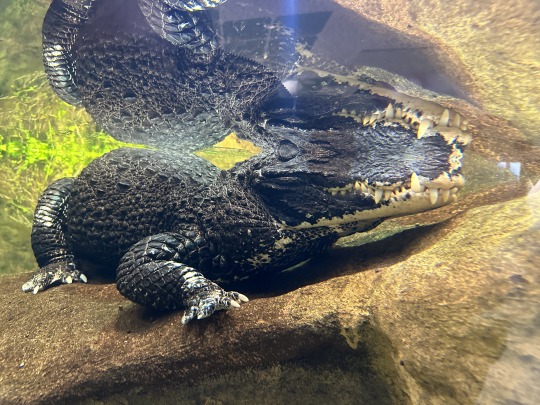
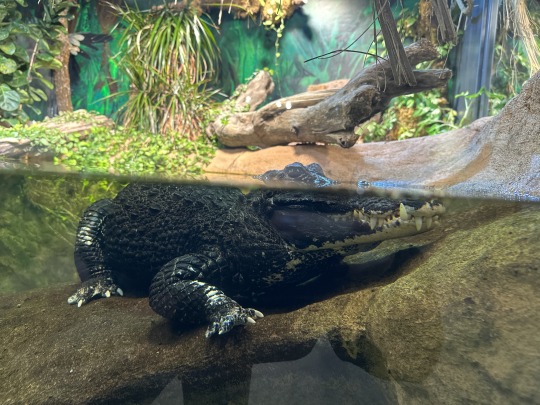
The first room furthermore featured two skulls, one of a crocodile and one of a gharial, nicely highlighting the diversity of modern crocodilians. Downstairs in the dinosaur hall they also displayed the skeleton of Macrospondylus, but given how common fossils of that animal are I wont dwell on it beyond saying that its size was rather impressive.


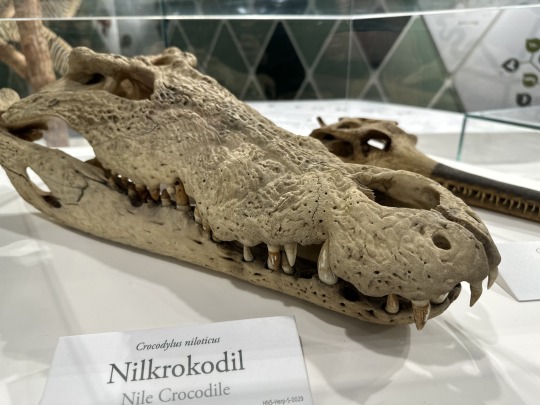


Skipping ahead a few days brought us back to Salzburg, this time to the zoo just outside the city. While featuring nothing too large, the jaguar house still showcased a crocodilian, specifically a dwarf caiman. Alas, despite stopping by around 5 times, it was less cooperative in terms of posing than my previous two encounters. Still, the enclosure was quite nice and featured some cohabitation with basilisk lizards and bats (that I sadly couldn't find).




The last zoo of the week was in Schmieding in Upper Austria. Now when I was a kid they had a nile and, in the adjacent aquarium, some spectacled caimans. However nowadays they scaled down, having moved the caimans into the old nile crocodile pool in the rainforest house. Funny enough they were the only ones on the trip to have been on land, tho they were looking a little rough if truth be told.

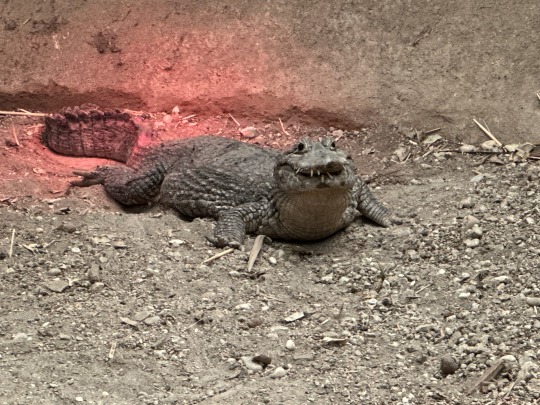
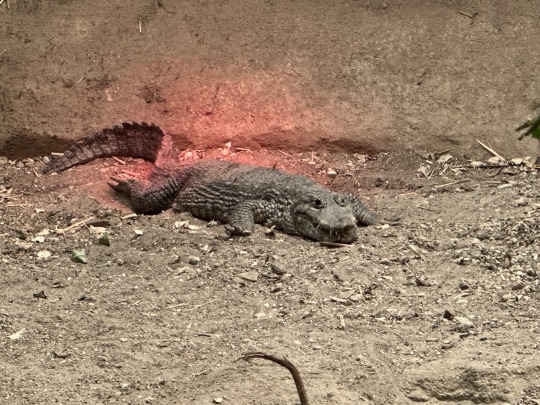
And that was it in broad strokes. Some were certainly more exciting than others, Leila remains a stand out and the new Salzburg Osteolaemus was nice to see. Obviously the trips featured a lot of other interesting stuff from 9 meter sturgeon models in Bratislava to free roaming ringtail lemurs and stuffed rhinogrades in Salzburg and plenty more, but alas all four species encountered were animals I have seen before, so I don't get to cross anything off my list this time around.
#haus des meeres#vienna#mecistops cataphractus#slender-snouted crocodile#haus der natur#museum#salzburg#osteolaemus#dwarf crocodile#gharial#nile crocodile#macrospondylus#dwarf caiman#zoo salzburg#paleosuchus#paleosuchus trigonatus#zoo schmieding#caiman#spectacled caiman#crocodiles#croc#pseudosuchia#crocodilia
72 notes
·
View notes
Text
Dandelion News - May 15-21
Like these weekly compilations? Tip me at $kaybarr1735 or check out my Dandelion Doodles! (EDIT: this was originally accidentally posted with only 3 articles, ig my internet farted, please rb this version with all 5 instead!)
1. Solar apprenticeships give Virginia students a head start on clean energy

“A regional partnership working to add solar panels to commercial buildings in the region aims to train young people as they go, developing workforce skills in anticipation of increasing demand for renewable energy-focused jobs in the heart of coal country, where skill sets and energy options are both changing. […] On top of hourly pay, apprentices get free equipment and a transportation subsidy, along with nine community college credits at Mountain Empire Community College, which provides classroom training before students step onto the job site.”
2. Generic drugs can be reliably supplied at big savings, study finds
“A new study finds that CivicaScript, a not-for-profit drug manufacturer in the US, can reliably supply essential generic medicines at a price that saves patients over 60%, and public and private insurers over 90%[….] The researchers say that CivicaScript's success proves that prioritizing patient access over investor profit in the generic pharmaceutical industry is not only possible, but also could be highly productive and cost efficient.”
3. This flat-bodied South African gecko was a 'lost' species. It's been found again after 34 years
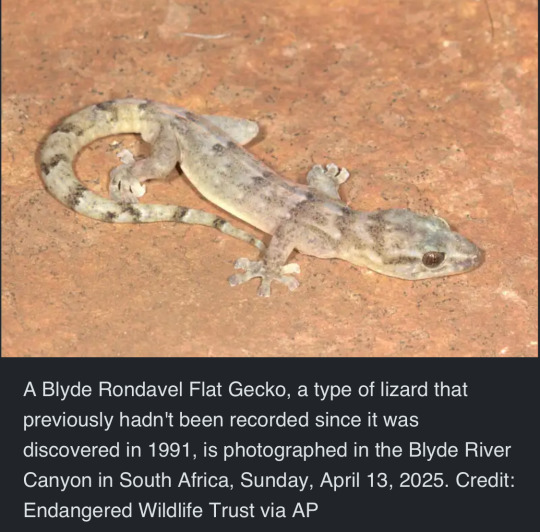
“[The species was discovered] in northeastern South Africa in 1991 only to not be seen again. [In April 2025, scientists] saw 20-30 specimens and captured and photographed seven, [… and] the data they collected, including tissue samples, should allow them to confirm it is a distinct species. […] A mole that lives in sand dunes was found in 2021 after having not been seen for more than 80 years, and a butterfly, a lizard and a frog species have also been found again in the last four years after being lost to conservationists for decades.”
4. Australian researchers to trial flat-packed, lower-cost concentrated solar technology

““Industrial process heat accounts for a staggering 25% of global energy use and 20% of CO2 emissions,” explained [one of the researchers]. [… This new technology can] generate temperatures between 100-400 degrees celsius, highlighting its potential for reducing several industries’ reliance on fossil fuels. With these sorts of temperatures, the proprietary CST modules would be ideal for several processes such as grain & pulse drying, sterilising and wastewater treatment.”
5. Morocco unveils policies it hopes bolster the care and management of stray dogs

“[…] Morocco’s updated approach balanced public safety, health and animal well-being [… by ensuring that stray dogs] are examined, treated [(vaccinated and neutered)] and ultimately released with tags that make clear they pose no danger. […] It’s designed to gradually reduce the stray dog population while minimizing the need for euthanasia.”
May 8-14 news here | (all credit for images and written material can be found at the source linked; I don’t claim credit for anything but curating.)
#hopepunk#good news#nature#solar panels#solar energy#solar power#solar#clean energy#renewableenergy#virginia#vocational training#medication#healthcare#prescription drugs#gecko#lizard#animal#australia#technology#morocco#dogs#dog#stray dogs#veterinary
68 notes
·
View notes
Text
Monday Musings: Tyrannosaurus did not become Chickens
There's nothing more annoying to me than all the misinformation about how evolution works and the whole "T. rex evolved into chickens" is ne of the big offenders.
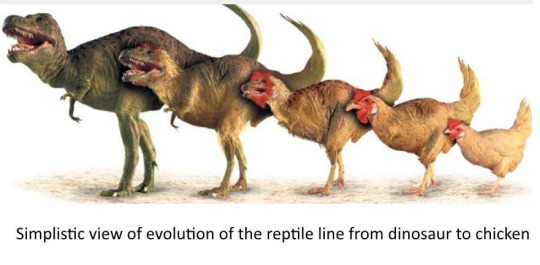
That's simply wrong. That's not how evolution works. Birds as a whole are a totally different branch of the dinosaur family from tyrannosaurs.

This is a more accurate depiction of how these two families are related. Sometime back in the Jurassic Period (we haven't found this piece, it is simply a hypothesis. Incidentally, that is another misunderstood word) the ancestor of both tyrannosaurs and aves existed. Something caused the two groups to divide. It could have been geographical separation (after all, Pangea was starting to break up).
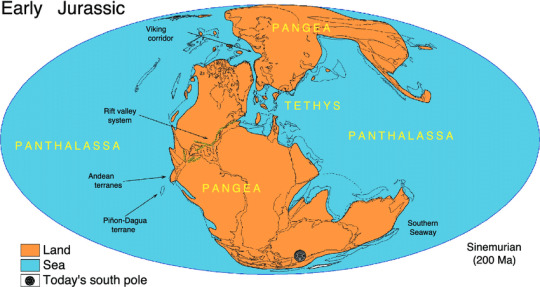
Perhaps it was something like a change in plumage or scale colors that made females choose one or the other type pf males leading to a split. Kind of like the Side-blotched Lizard. They haven't totally split but certain belly colors are preferred over others.
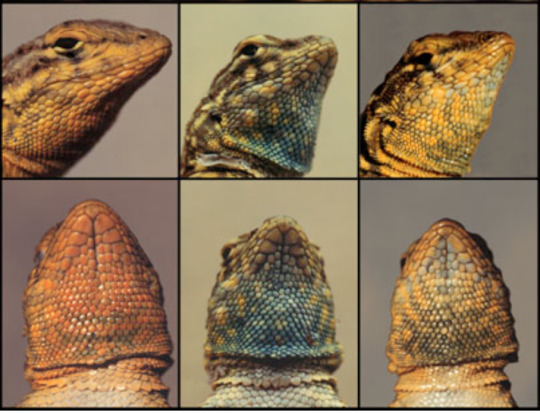
Whatever the reason, they did split and created two very different groups. One got bigger and bigger until they were some of the largest land carnivores to exist while the other got smaller and learned to fly.
Tune in tomorrow for some more tyrannosaur trivia! Fossilize you later!
#paleontology#fossils#fun facts#dinosaur#science#science education#tyrannosauridae#chicken#evolution#science side of tumblr
64 notes
·
View notes
Text
Hiya, tiny tot! Welcome to my kindie (kindergarten)!
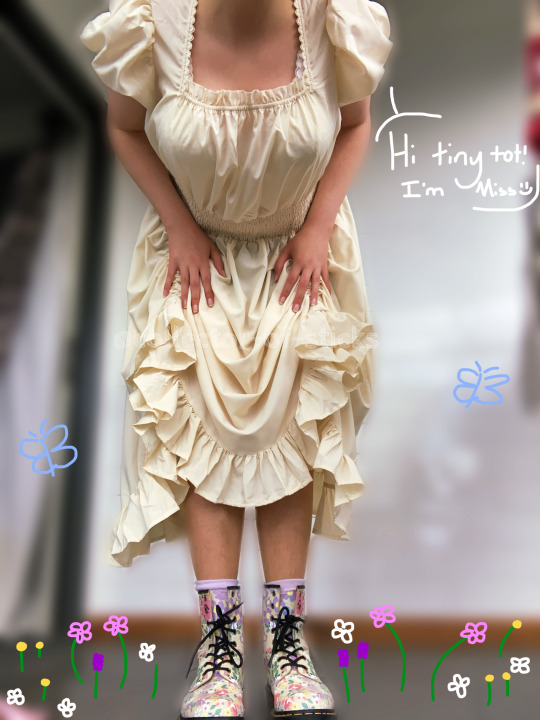
Would you like to do some colouring and learn about native animals?
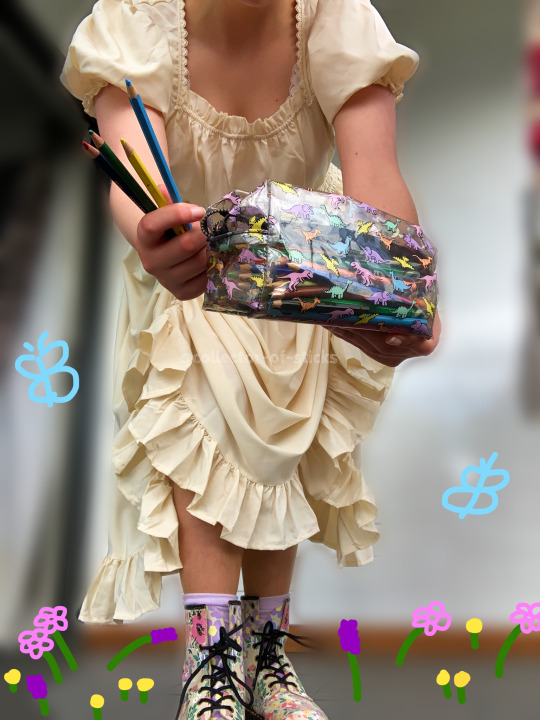
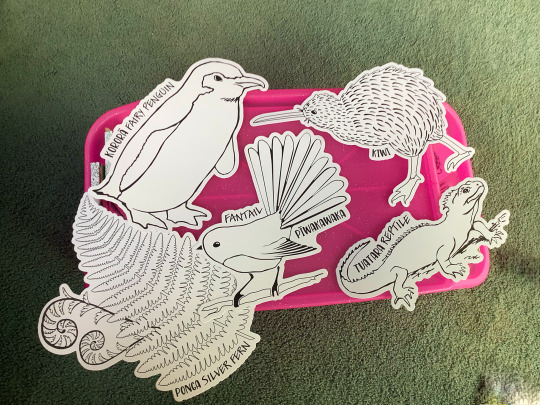
More under the cut including snack time, reading time, and animal facts!
Kiwi
- is a bird but can’t fly! It’s wings are about the size of a pinkie finger
- has nostrils at the end of its beak so it can smell bugs in the ground
- has whiskers like a cat!
- it’s feathers are more like a fur coat and moult all year round
- has powerful, strong legs!
- has the biggest egg to bird ratio in the world! Its eggs are massive compared to its size!
- nocturnal! Sleeps during the day :)
Fantail/pīwakawaka
- they use their fan-like tail to make quick turns when hunting insects!
- they make such cute lil chirping sounds
- they never hunt on the ground and can be found upside down on ferns and other plants looking for bugs!
- they can live up to three years
- pīwakawaka is the Māori name for which it means a messenger, bringing death or news of death from the Gods to the people. Waka means canoe (a type of boat)
Little blue penguin/fairy penguin/kororā
- is the worlds smallest penguin! So tiny, like you!
- they can dive as deep as 35m/114 feet :O
- in Australia they’re called fairy penguins because they’re so little
- they come inland to build their nests and will travel very very far! (1.5km/0.93mile inland, climbing up to 300m/984 feet)
- prey includes small shoaling fish, squid, and crustacean species
Tuatara (reptile)
- is not actually a lizard! It’s the only living member of the order Rhynchocephalia (such a big word!)
- it’s a living fossil, meaning it was around when the dinosaurs were! Wow.
- the name tuatara comes from te reo Māori for “peaks on the back”
- they live for super long. They don’t stop growing until they’re 30 and in the wild are thought to live up to 100 years old!
- they hibernate during the winter and have a lower body temperature compared to other reptiles :O
- they can regrow lost tails
- they’re diurnal when young (awake during the day) but nocturnal when adults (awake during the night)
Snack time! Don’t forget to drink water today <3


Home made biscuits… yum!
And a quick story before playtime
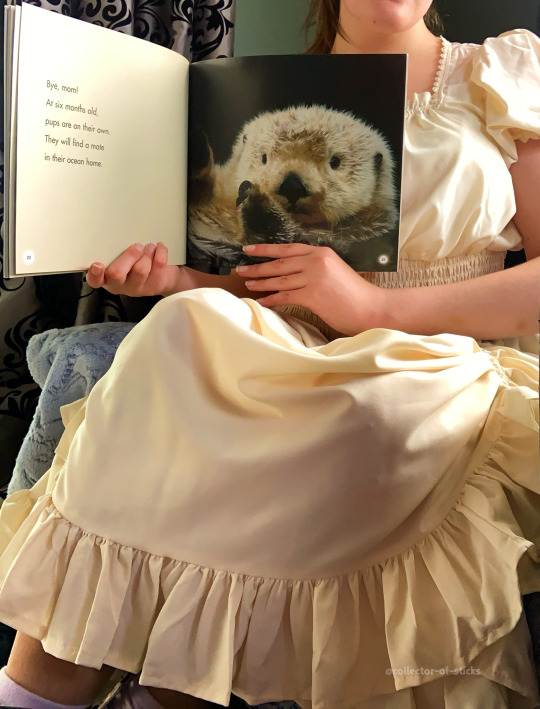
https://www.tumblr.com/collector-of-sticks/760038280135901884/i-just-read-a-picture-book-about-baby-sea-otters
Facts about sea otters ^^
I’ll see ya after playtime! Go out and have some fun!
🧸 🌿🍄🌸🌈⚽️🎭🎲🧩

#sfw agere#sfw littlespace#sfw cglre#sfw regression#sfw caregiver#agere little#cglre little#age regressor#cglre#cglre community#agere daycare#agere caregiver#age regression#sfw agedre#agedre#age dreaming#cglre caregiver
111 notes
·
View notes